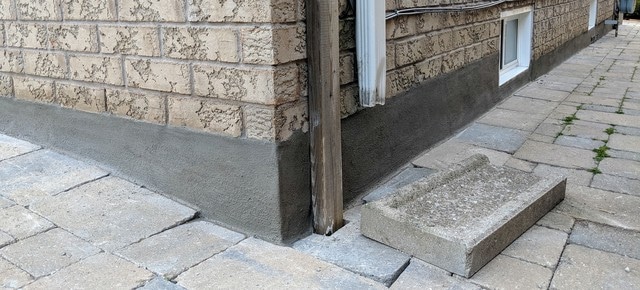






Parging is a way to apply a smooth surface to a masonry wall.
It is used to apply a smooth surface to the exterior of a concrete foundation so that a waterproofing compound can be applied more easily.
Parging is also frequently used to cover up deteriorating masonry on the outsides of buildings or to provide a smooth surface for the application of new finishes on the inside and outside of a building.
Older Toronto parged walls begin to deteriorate. They show many cracks, and a part of the outer layer starts falling off. At this point, the old parging is fully removed and redone which gives your building or home a brand new look.
Parging in Toronto, sometimes but not very often, is used in new construction to artificially age a building. This is usually done in movies props etc.
The material used is mortar or Portland-cement based and is applied with a trowel, usually in several thin coats, directly over the masonry that it repairs or conceals. One should never put it over deteriorating bricks as the bricks will not hold the layers of mortar very well as the bricks will continue to deteriorate beneath. Always repair the wall then parge over the repaired wall.
Stucco can have a similar appearance or it may have a textured or decorative appearance.
Parging is commonly used at the bottom of a brick wall, your foundation, to protect the most vulnerable part of a home or building from water and snow. This is accomplished by applying a special type of cement to create a smooth flat surface on your home or buildings foundation.
Parging is also used on exterior house walls and even on chimney’s to give your house a very smooth and classic look. Parged walls can also be painted.

Parging is commonly used at the bottom of a brick wall to protect the most vulnerable part of a building from water and snow. This is accomplished by applying a special type of cement to create a smooth flat surface. This is called foundation Parging as it protects moisture from getting into the found of your home.
If you don’t keep up with the parging, water can get stuck between the wall and the coating, which can easily cause more damage, like spalling, where the concrete becomes flaky, pitted, or broken. If the parging can be fixed at all, it can be expensive, stressful, and take a long time.
If you live in an area prone to flooding, hire a professional to repair or replace your foundation parging. Don’t take chances with nature!
Parging also makes your home more energy efficient by sealing holes and leaks in your concrete walls.
So If you take care of and maintain your home’s parging, you won’t have to worry about needless and expensive repairs.
SurGuard® utilizes the most stable, inorganic components and pigments to ensure total weatherability and permanence of colour. It repels rain, sleet and snow and virtually eliminates vulnerability to the elements.
SurGuard® Acrylic Coating offers unparalleled durability and longevity, all while adding a vibrant splash of colour to enhance your home’s curb appeal.
Here are the advantages:
A&A Masonry is an award-winning Toronto based firm specializing in almost everything exterior.
Our mission is to offer a unique and reliable service in anything exterior within the Greater Toronto Area, differentiating ourselves from the competition by means of always delivering what we promise, on time and on budget.
Send us Email
ADDRESS
33 Billingham Road Etobicoke ON M9B 3X2